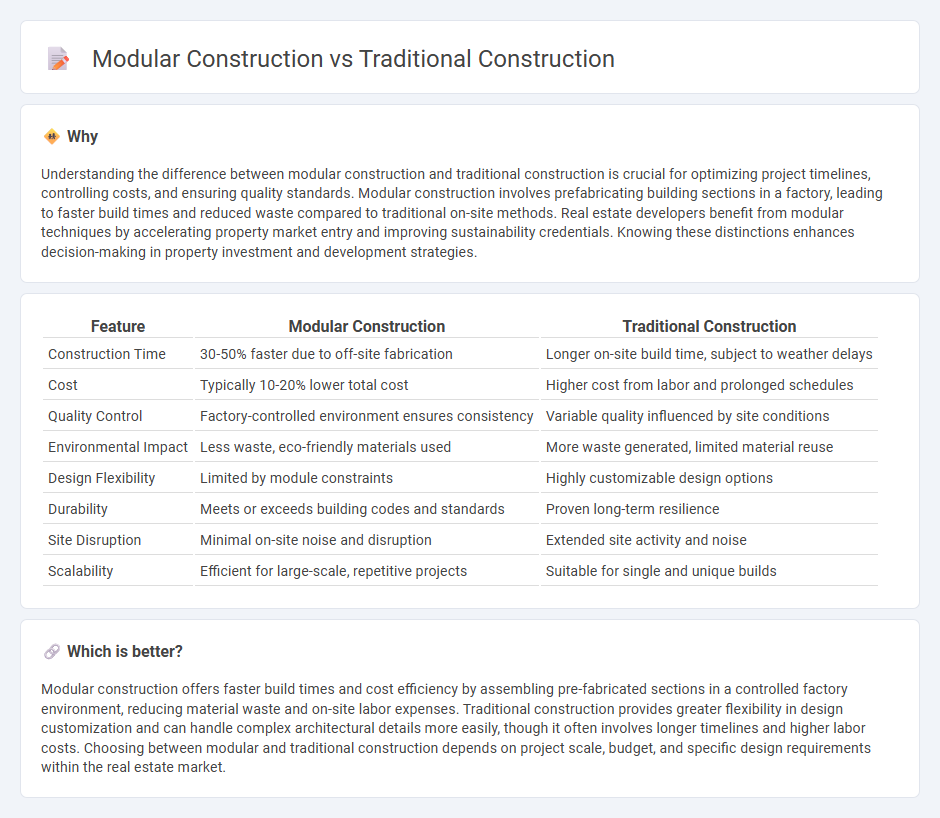
Modular construction reduces build time by up to 50% compared to traditional construction, offering improved cost efficiency and less on-site disruption. Traditional construction, while more labor-intensive, provides greater flexibility in design and customization, often preferred for complex architectural projects. Explore the benefits and challenges of both methods to determine the best fit for your real estate development needs.
Why it is important
Understanding the difference between modular construction and traditional construction is crucial for optimizing project timelines, controlling costs, and ensuring quality standards. Modular construction involves prefabricating building sections in a factory, leading to faster build times and reduced waste compared to traditional on-site methods. Real estate developers benefit from modular techniques by accelerating property market entry and improving sustainability credentials. Knowing these distinctions enhances decision-making in property investment and development strategies.
Comparison Table
| Feature | Modular Construction | Traditional Construction |
|---|---|---|
| Construction Time | 30-50% faster due to off-site fabrication | Longer on-site build time, subject to weather delays |
| Cost | Typically 10-20% lower total cost | Higher cost from labor and prolonged schedules |
| Quality Control | Factory-controlled environment ensures consistency | Variable quality influenced by site conditions |
| Environmental Impact | Less waste, eco-friendly materials used | More waste generated, limited material reuse |
| Design Flexibility | Limited by module constraints | Highly customizable design options |
| Durability | Meets or exceeds building codes and standards | Proven long-term resilience |
| Site Disruption | Minimal on-site noise and disruption | Extended site activity and noise |
| Scalability | Efficient for large-scale, repetitive projects | Suitable for single and unique builds |
Which is better?
Modular construction offers faster build times and cost efficiency by assembling pre-fabricated sections in a controlled factory environment, reducing material waste and on-site labor expenses. Traditional construction provides greater flexibility in design customization and can handle complex architectural details more easily, though it often involves longer timelines and higher labor costs. Choosing between modular and traditional construction depends on project scale, budget, and specific design requirements within the real estate market.
Connection
Modular construction and traditional construction share the fundamental goal of creating durable, functional buildings but differ in methodology and timeline. Both methods utilize core building materials like concrete and steel, with modular construction emphasizing prefabrication in controlled environments to reduce on-site labor and construction waste. This synergy allows developers to choose the best application depending on project scale, cost constraints, and desired completion speed, advancing efficiency in the real estate industry.
Key Terms
On-site Building
Traditional construction involves building structures entirely on-site, often resulting in longer project timelines and increased exposure to weather delays. Modular construction fabricates building components in a controlled factory environment, reducing on-site labor and accelerating assembly. Explore the benefits and innovations of on-site building methods to optimize your construction projects.
Prefabrication
Traditional construction relies on on-site building processes, often leading to longer project timelines and increased labor costs. Modular construction uses prefabrication techniques, manufacturing building components in controlled factory settings to ensure higher quality, faster assembly, and reduced waste. Explore the advantages of prefabrication in modular construction to understand its impact on efficiency and sustainability.
Construction Timeline
Traditional construction projects often extend over several months due to sequential processes like site preparation, foundation laying, and on-site assembly. Modular construction significantly reduces build time by fabricating components off-site simultaneously while foundation work proceeds, enabling faster project completion and early occupancy. Explore detailed timelines and case studies to understand the efficiency benefits of modular construction over traditional methods.
Source and External Links
What is Traditional Construction? - Explains traditional construction as conventional methods involving natural materials and manual techniques, emphasizing durability and reliability.
Design-Build vs. Traditional Construction - Discusses traditional construction as a method with separate design and construction phases, offering advantages in project organization and control.
Design Build vs. Traditional Construction Methods - Compares traditional construction (Design-Bid-Build) with design-build methods, highlighting its use in projects requiring cost predictability and design control.
 dowidth.com
dowidth.com